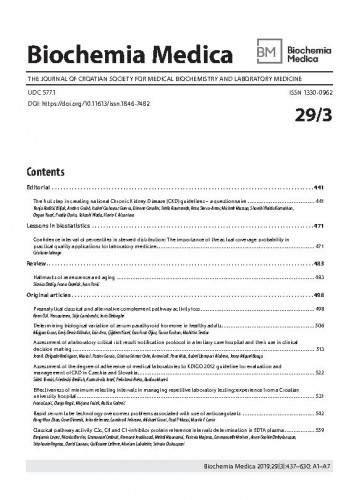Introduction: Our aim was to compare analytical specifications of two assays (monoclonal vs. polyclonal) for free light chains (FLCs) quantificationoptimized for two different analytical platforms, nephelometer ProSpec (Siemens, Erlangen, Germany) and turbidimetric analyser Optilite (The BindingSite, Birmingham, UK).Materials and methods: The evaluation included verification of the precision, repeatability and reproducibility, estimation of accuracy and methodcomparison study with 37 serum samples of haematological patients. Kappa and lambda FLC were measured in each sample by both methodsand kappa/lambda ratio was calculated.Results: Results show satisfactory precision of both methods with coefficients of variation for ProSpec of CVwr = 2.20% and CVbr = 3.44%, and forOptilite CVwr = 2.82% and CVbr = 4.15%. Estimated bias for FLC lambda was higher on the ProSpec analyser, but bias for FLC kappa was higher on theOptilite analyser. Correlation coefficients were 0.98; P <0.001 for FLC kappa and 0.97; P <0.001 for FLC lambda. Considering normal/pathologicalFLC ratio moderate agreement within assays was detected (κ = 0.621). When the results were categorized according to criteria for progressive disease,4/37 (0.10) cases were differently classified. Lambda FLC values by Optilite in three samples with monoclonal FLC lambda were more than twelvetimes higher than by ProSpec. A 25% difference in FLC ratio was detected in 16/37 (0.43) and 50% difference in 13/37 (0.35) patients.Conclusions: All manufacturers’ precision claims could not be achieved in the verification study. The comparison of results to biological variationsdata showed that coefficients of variations are acceptable for both assays. The assays should not be used interchangeably in haematological patients.
Sažetak

 Biochemia medica : the journal of Croatian Society for Medical Biochemistry and Laboratory Medicine : 29,3(2019) / glavna i odgovorna urednica Daria Pašalić.
Biochemia medica : the journal of Croatian Society for Medical Biochemistry and Laboratory Medicine : 29,3(2019) / glavna i odgovorna urednica Daria Pašalić.